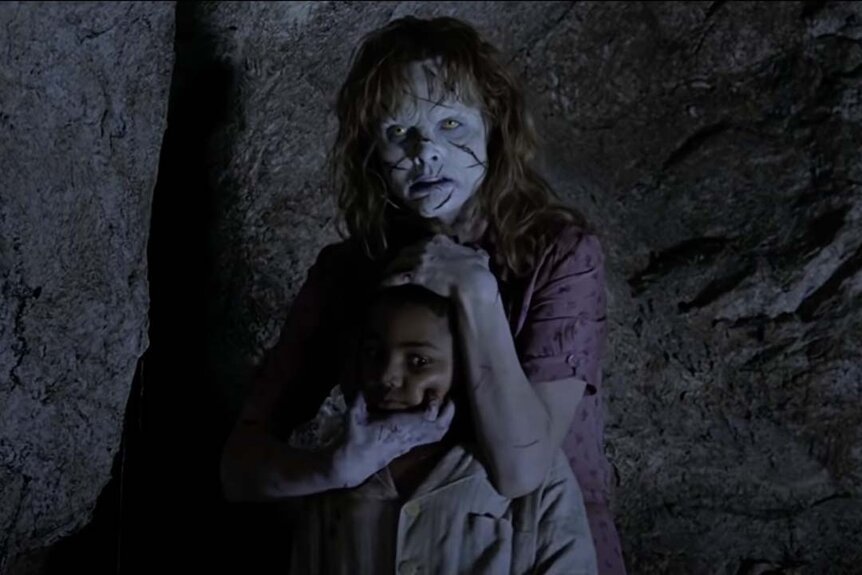Create a free profile to get unlimited access to exclusive videos, sweepstakes, and more!
Wait, So Why Are There Two Different Exorcist Prequels?
That time The Exorcist franchise broke down into a battle of the prequels.
Though it has spawned plenty of sequels, The Exorcist wasn't actually created with franchise potential in mind. But after the original film became a runaway hit in 1973, what happened next got a little twisty. It took four years to produce a sequel, the poorly received Exorcist II: The Heretic, and another 13 years to produce the third installment in the series, the much-improved The Exorcist III. From there, the franchise went dormant again for more than a decade, until it re-emerged in the 2000s with... two prequels?
Yes, The Exorcist ended up with not one, but two prequels: Dominion: Prequel to the Exorcist and Exorcist: The Beginning, both of which are streaming now on Peacock. Both films lay out the origin story of Father Lankester Merrin, the priest portrayed by Max von Sydow in the original 1973 film. And when we say two prequels, we don't mean they tell one long story across two installments, or tell two standalone stories meant to portray Merrin's formative years as an exorcist. No, these are two prequels that set out to tell a version of the same story, made by different directors with different versions of the same story. Even the quest for the Zack Snyder's definitive version of Justice League never went quite this far.
RELATED: Everything to Know About The Exorcist: Believer
So, how did we get here? Why are there two Exorcist prequels, and what's different about them? Let's take a closer look.
The First Exorcist Prequel
Our story begins, more-or-less, with producer James G. Robinson, who brought Exorcist III to the screen in 1990, and just a few years later, started looking for other ways to keep the franchise alive. By 1997, Robinson had a prequel in mind, and brought in Terminator 2 writer William Wisher to craft a script about Merrin's first, formative brush with exorcism. After a rewrite from The Alienist creator Caleb Carr, legendary director John Frankenheimer (The Manchurian Candidate) signed on to make the film, and cast Liam Neeson in the role of Merrin.
So far so good, right? Well, here's where things get twisty. According to The New York Times, Frankenheimer joined the film in 2001, after reading Carr's draft, but his health wasn't good. By 2002, the aging director was forced to back away from the project, and Neeson left with him. By July of that year, Frankenheimer had passed away at the age of 72, leaving the film without a director or a star. Keep Wisher and Carr's names in mind, though, because they'll stick around in the credits for the duration.
Some movies might have been scrapped at this point, but Robinson wanted to keep moving, and with help from Morgan Creek head, Guy McElwaine, he brought in Paul Schrader, a writer/director best known for his scripts for films like Taxi Driver and, these days, indie character dramas like The Card Counter and First Reformed. Schrader hadn't made a major studio release since Cat People two decades earlier, but he saw some interesting opportunities in an Exorcist prequel, and joined the project. By the fall of 2002, Schrader had cast Stellan Skarsgard in the role of Merrin, and everyone headed off to shoot the movie. So we're back on track, right?
RELATED: How Exactly Did Linda Blair Contribute To The Exorcist: Believer As Technical Advisor?
Well, that may have been true throughout principal photography, but when Schrader came back and showed Robinson his first cut of the film, the producer wasn't pleased.
''The movie was plain not scary enough,'' Robinson told The New York Times. ''The cut that I looked at was not going to work.''
Schrader was given one week to work through a new cut of the film, but that version didn't pass muster with the producers either. So, Robinson and McElwaine brought in a new editor to cut the film without Schrader, which sent the director into a bit of a self-imposed exile. Months passed, and Schrader tried to reassert some authority, even requested the chance to do reshoots, to no avail. Schrader's film was, for Robinson, just not the horror-focused thrill ride he had in mind.
''I felt he'd done the best he could do,'' Robinson said. ''I told him we appreciated his work and we were finding a new director.''
Reflecting on the situation to The New York Times later, Schrader would put it like this: "It comes down to a case of buyer's remorse. [Robinson] saw the film and decided he wanted another one.''
So, Robinson went in search of his new film, and Schrader's footage mostly went away... for a while, at least.
The Second Exorcist Prequel
Robinson eventually chose Renny Harlin –– an action filmmaker best known for work like Die Hard 2 and Cliffhanger –– to helm his new vision of the prequel, after Harlin pitched the prequel as something that could use more overt horror, more action, and more generally blockbuster-friendly storytelling. By now, it was clear that the original summer of 2003 release date wasn't going to work, so Harlin got to work on retooling Wisher and Carr's script, working with multiple writers including eventual credited screenwriter Alexi Hawley (Wisher and Carr have a Story By credit on the final film).
But this wasn't just a case of a few reshoots to add or tweak key scenes. No, in Harlin's eyes, this was a complete teardown, a chance to build his own version of the story from the ground up.
“They were wondering: What can we do? Can we insert a few scenes and spice it up to make it more suspenseful?” Harlin told the Los Angeles Times. “I said, ‘The only way to have a scary film is to start from scratch.’ ”
So Harlin did, keeping only Skarsgard from Schrader's cast, rebuilding the sets to suit his needs, and shooting in late 2003 to make a now-summer 2004 release date. In keeping with the long-running whispers of an Exorcist curse, Harlin also had to direct from crutches for weeks after a car accident broke his leg. This time, though, at least the final cut of the film sat well enough with Robinson. The prequel, titled Exorcist: The Beginning, was done, and finally hit theaters in August of 2004.
But of course, that's not the end of the story.
The Two Prequels
Exorcist: The Beginning ended up grossing $78 million worldwide, making back its budget and a healthy chunk more. But the reviews weren't good, and when Schrader went to see the film on opening weekend –– with William Peter Blatty in tow, no less –– he realized an opportunity could soon present itself.
"I was looking at this, saying, 'This is really bad. If it stays this bad, I bet there's a chance I can get mine resurrected'," Scrhader recalled in an interview with The Independent.
Sure enough, Schrader got his wish. Hoping to make some money back on what they'd sunk into making two separate films, Morgan Creek eventually approached the filmmaker about releasing his version of the story. Dominion: Prequel to the Exorcist arrived on home video in the spring of 2005, and while the reviews weren't exactly glowing, it did have some notable champions, including legendary critic Roger Ebert.
So, what's so different about these two films? On a surface level, they're basically about the same thing. Merrin, his faith shattered after witnessing the atrocities of World War II firsthand, heads to Africa to pursue his love of archaeology, taking a sabbatical from the Church in the process. While there, he visits a mysterious dig site in Kenya, a Byzantine church deliberately buried to contain an ancient evil, and must face the dark forces that surround the local villagers and the encroaching British soldiers. Along the way, his father returns to him, and he once again becomes Father Merrin, the Exorcist.
Harlin's version, with rewrites from the original script, is more overtly horror-heavy, with jump scares and big demonic moments peppered into Merrin's journey, including a final battle with a demon in the tunnels beneath the church. It's got more sex appeal, a more cinematic visual approach, and a story that reaches for bigger plot ideas than Schrader's version.
In Dominion, the plot takes on something a bit more cerebral, as Schrader reworked Carr and Wisher's script into the story of a man who must ponder the realities of everyday evil as a tangible, irrefutable thing, even as an evil that's more subversive and shadowy starts to creep in. It certainly has its share of scares, but they're more subtle, less rooted in jack-in-the-box jumps, and all in service to the character drama for which Schrader is known.
Which one's better? Well, it all comes down to your preference in terms of the approach, but the general consensus is that Schrader turned in the more thoughtful, emotionally interesting film. But no matter which version you prefer, what remains true is that The Exorcist ended up with something basically no other major horror franchise has ever gotten, two versions of the same story delivered by very different filmmakers, both of which we can go and watch right now. It's a fascinating moment in horror history, and serves as proof that there's something about this world and these characters that just refuses to leave the public imagination.
Dominion: Prequel to the Exorcist and Exorcist: The Beginning are both available to stream on Peacock.
Originally published Oct 2, 2023.































